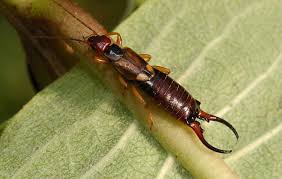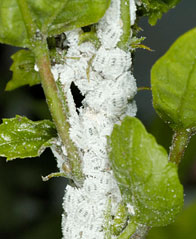 During the summer months, there are many things in our yard that demand our attention. But while we are keeping everything looking nice there may be a problem that is forming on your trees and shrubs without you even noticing. Scale insects are so small that you may not notice their presence on a tree until they begin doing some real damage.
During the summer months, there are many things in our yard that demand our attention. But while we are keeping everything looking nice there may be a problem that is forming on your trees and shrubs without you even noticing. Scale insects are so small that you may not notice their presence on a tree until they begin doing some real damage.
Scale insects are a class of insects named for the protective scales that cover their bodies. They are typically very small (up to 1/8 of an inch) and without any legs, they move quite slowly if at all. Scale insects usually survive by finding a good spot along the veins of a leaf and sucking the sap from the leaf. As long as the leaf continues to provide an adequate supply of sap, they will happily set up camp and stay.
While this sounds like a nice arrangement for the scale insect, it doesn’t really work out so well for the tree or shrub. A healthy tree produces a lot of sap and one scale insect probably wouldn’t do much damage. However, like many pests, these insects reproduce rapidly and each new generation will find a comfy spot, usually on the same tree, and start sucking away. The euonymus variety of scale insects can produce up to 3 generations each year! A constant drain of sap will eventually take its toll on the tree or shrub.
 In addition to putting stress on your trees, scale insects also make a mess in and under your trees. As they are gorging themselves on sap, these little creatures are also excreting a sticky substance all over the leaves on which they live. This substance, romantically known as honeydew, covers tree leaves as well as dropping onto the ground or anything else parked under the tree. If left undisturbed, honeydew will often lead to the formation of a black sooty mold.
In addition to putting stress on your trees, scale insects also make a mess in and under your trees. As they are gorging themselves on sap, these little creatures are also excreting a sticky substance all over the leaves on which they live. This substance, romantically known as honeydew, covers tree leaves as well as dropping onto the ground or anything else parked under the tree. If left undisturbed, honeydew will often lead to the formation of a black sooty mold.
Let us look at some evidence caused due to these pesky little insects
Scale insect attacking coastal vegetation raises concerns
16/6/2017, LSU Ag Center
The insect, Phragmites scale, is attacking Roseau cane, a plant that grows profusely along the coast. It is considered vital to the fragile marsh’s longevity because the plant’s root system binds the delicate soil. Large stands of the cane have been decimated by the pest, starting in the Mississippi River delta in Plaquemines Parish, and it has been found in other areas.
“This is the next new threat to Louisiana’s coast,” said Randy Myers, assistant secretary of the Louisiana Department of Wildlife and Fisheries. “This is a significant problem.”
It’s unknown how the scale insect arrived in Louisiana, Diaz said. It has been intercepted in previous years at ports in Hawaii and California.
The scale could be spread by birds, floating pieces of Roseau cane or boats, he said.
UW-Extension: Scale causing a sticky mess
August 24, 2015, Walworth County Today
Christine Wen began fielding calls earlier this month from Fontana and Williams Bay residents puzzled by the sticky sap covering not only plants but cars and patios.
The culprits, said Wen, a horticulture educator at the University of Wisconsin-Extension Walworth County office in Elkhorn, is an explosion of scale insects on many different species of mature trees in the area.
There are several different types of scale, but the insects all feed by sucking large amounts of sap from trees, Wen said.
The insects are more of a nuisance to people. Wen said when scale feed on the sap of leaves and twigs, they secrete a sticky liquid called honeydew. The liquid, which is often mistaken for sap, coats tree leaves and branches, and drips down to whatever is beneath. The honeydew is also a source of food for sooty mold fungus, which results in a black crust over surfaces.
The current insecticides are being used to control this menace. Due to the protective scale which covers these insects, they are often resistant to normally sprayed insecticides. So what can we do to eliminate these tiny pests?
At C Tech Corporation we offer a safe and effective solution to deal with these insects. Combirepel™ is a non-toxic and non-hazardous product that primarily repels insects from the application. The best feature of this product that it is environmentally safe and causes no harm to insects as well as for humans.
Combirepel™ is thermally stable and does not degrade on exposure to heat and sunlight. It does not kill or harm the insect but repels them. It does not volatilize and does not degrade the soil. It is RoHS, RoHS2, ISO, REACH, APVMA, NEA compliant and FIFRA exempted.
Combirepel™ is available in the form of the masterbatch, liquid concentrate, and lacquer which can be applied topically to the applications.
To keep the insects at the bay Combirepel™ can be sprayed or coated on the tree trunks.
The masterbatch can be incorporated in plastic mulches, tree guards, agricultural films etc. used to cover trees.
The liquid concentrate can be mixed in paints in a pre-determined ratio and can be applied on the concrete fences around the trees and farms. This will prevent the pest entry into the areas of plantation.
Combirepel™ is effective against a multitude of other insects and pests like beetles, mayflies, thrips, aphids, etc.
Our product works on the mechanism of repellency. It temporarily inhibits the mating cycle of the insects. The product impairs the ability of the insects to reproduce, that is the insects will not lay eggs or the laid eggs will be infertile. The product causes feeding disruption in an insect by triggering an unpleasant reaction within the insect which might try to feed on the application. The product temporarily blocks the reproduction system of the insects by hindering the release of the vital hormones for growth.
The repelling mechanism of the product would ward off the scale insects and other insects that could damage the trees. Thus by using Combirepel™ would effectively ensure that trees remain safe and protected for a long period of time.
Contact us at technical.marketing@ctechcorporation.com to keep the pests away.
Also, visit our websites:
http://www.ctechcorporation.com/
http://www.rodrepel.com/
http://www.termirepel.com/
http://www.combirepel.com/
Follow our Facebook pages at:
1] https://www.facebook.com/Combirepel-411710912249274/
2] https://www.facebook.com/Termirepel-104225413091251/
3] https://www.facebook.com/Rodrepel-120734974768048/
Follow us on our Twitter pages at:
1] https://twitter.com/rodrepel
2] https://twitter.com/termirepel
3] https://twitter.com/combirepel





















